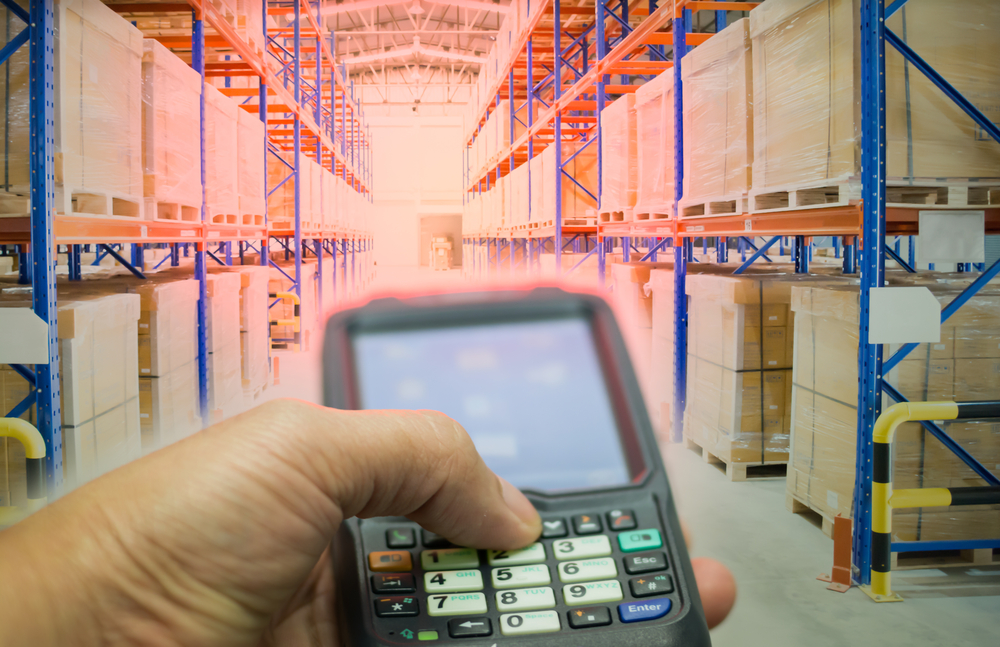In a warehouse with tens of thousands of square feet of storage, it can be difficult to maintain an accurate picture of inventory and overall operations. Even pallet-level barcodes do not resolve this issue, as a barcode reader must have a direct line of sight to capture a barcode’s data. This means relying on warehouse employees to manually scan each product load. To streamline this process and to decrease the risk of human error, many businesses are increasingly turning to Radio Frequency Identification (RFID) implementation.
In industries such as grocery and apparel manufacturing, errors in inventory control systems can lead to a potential loss in sales. RFID tags attached to each product lowers the cost of the overall inventory by reducing out-of-stocks. While item-level RFID tagging of individual products is not cost-effective for most supply chains, pallet-level tagging of shipments provides a way to easily keep track of inventory without a large initial expense.
The Rise of Pallet-Level Tagging
 An RFID tag attached to a pallet stores information about the products on that pallet as they move through the supply chain. With the help of an electromagnetic signal, an RFID tag transmits the information it contains to a centralized Warehouse Management System (WMS) database that analyzes the data. Using pallet-level RFID tagging, warehouses can receive critical real-time updates about shipments in the supply chain and improve the accuracy of inventory management without tagging individual product items.
An RFID tag attached to a pallet stores information about the products on that pallet as they move through the supply chain. With the help of an electromagnetic signal, an RFID tag transmits the information it contains to a centralized Warehouse Management System (WMS) database that analyzes the data. Using pallet-level RFID tagging, warehouses can receive critical real-time updates about shipments in the supply chain and improve the accuracy of inventory management without tagging individual product items.
Tagging wood pallets with RFID is an expensive and often fruitless proposition.
RFID implementation in the warehouse using pallet-level tags is not a new concept. Back in 2003, Walmart asked their suppliers to attach RFID tags to all cases and pallets of incoming loads. However, they faced resistance from vendors, mainly due to the cost of RFID tags.
Over the years, the price of RFID tags has dropped dramatically, yet many businesses still hesitate to implement RFID technology. A major factor is the challenge of attaching RFID tags to easily damaged wood pallets, which often crack or lose boards during use. As a result, tagging wood pallets with RFID is an expensive and often fruitless proposition. Switching to plastic pallets is a cost-effective alternative that can address this issue.
RFID Implementation in the Warehouse Using Plastic Pallets
 Wood pallets absorb moisture with repeated usage across the supply chain. Fluctuations in moisture cause the wood to expand and contract and can contribute to fungi growth, making these pallets less usable over time. Wood pallets may harbor pests and can spread contamination across warehouses. The presence of splinters and protruding nails on the surface of wood pallets may lead to product damage and employee injury. Compared to wood pallets, high-quality plastic pallets offer a number of benefits that complement RFID implementation in the warehouse, such as:
Wood pallets absorb moisture with repeated usage across the supply chain. Fluctuations in moisture cause the wood to expand and contract and can contribute to fungi growth, making these pallets less usable over time. Wood pallets may harbor pests and can spread contamination across warehouses. The presence of splinters and protruding nails on the surface of wood pallets may lead to product damage and employee injury. Compared to wood pallets, high-quality plastic pallets offer a number of benefits that complement RFID implementation in the warehouse, such as:
- Durability: Their unibody construction and the absence of any loose boards make plastic pallets exceptionally durable and strong. Unlike wood pallets, the load capacity of a plastic pallet remains consistent throughout its lifespan. A plastic pallet can make as many as 100 trips through the supply chain before being recycled, which makes RFID tagging cost-effective.
- Reduced product damage: The lack of any splinters or protruding nails on the surface of a high-quality plastic pallet prevents the puncture of packaging that could lead to contamination and product loss.
- Better hygiene: Since plastic surfaces do not absorb moisture, plastic pallets offer better protection against contamination by microorganisms and chemicals. Also, the surface of plastic pallets can be easily cleaned to remove any contaminants, providing a hygienic warehouse environment.
- Increased employee safety: With their weight of about 50 pounds, plastic pallets can be easily lifted by a single employee in the warehouse, while ergonomic handholds and a smooth surface reduce the chance of employee injury.
- Automation-friendly: Plastic pallets are much better suited for use with warehouse automation than wood pallets. The consistent weight and dimensions of plastic pallets, as well as their lack of nails or splinters, reduce the likelihood of downtime in warehouses using Automated Storage and Retrieval Systems (ASRS).
- Pallet pooling: The cost of RFID-embedded plastic pallets is one of the key reasons that businesses may delay introducing them into the supply chain. However, a plastic pallet pooling program allows logistics managers to do away with the complicated management and maintenance of an internal pallet pool as well as the initial outlay of purchasing pallets. A pallet pooling provider will manage the end-to-end delivery, retrieval, and maintenance of RFID-enabled plastic pallets.
The durability and resilience of high-quality plastic pallets makes RFID implementation in the warehouse effective as well as cost-efficient, allowing you to increase productivity and efficiency.
iGPS plastic pallets carry embedded RFID tags that ensure readability and durability. To learn more about how to rent our durable, trackable plastic pallets, give our team a call at 1-800-884-0225, email a specialist at switch@igps.net, or visit our contact page.



